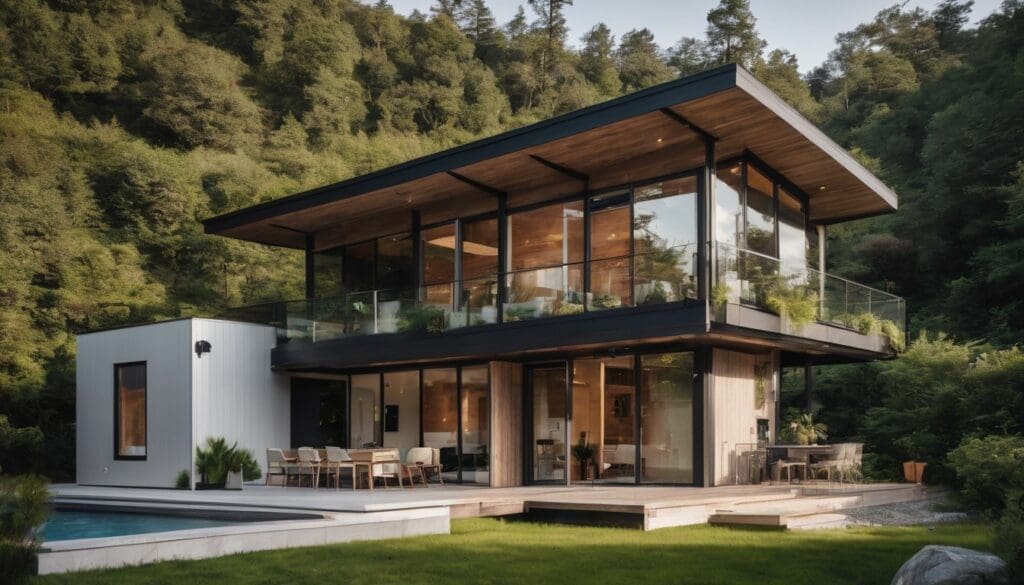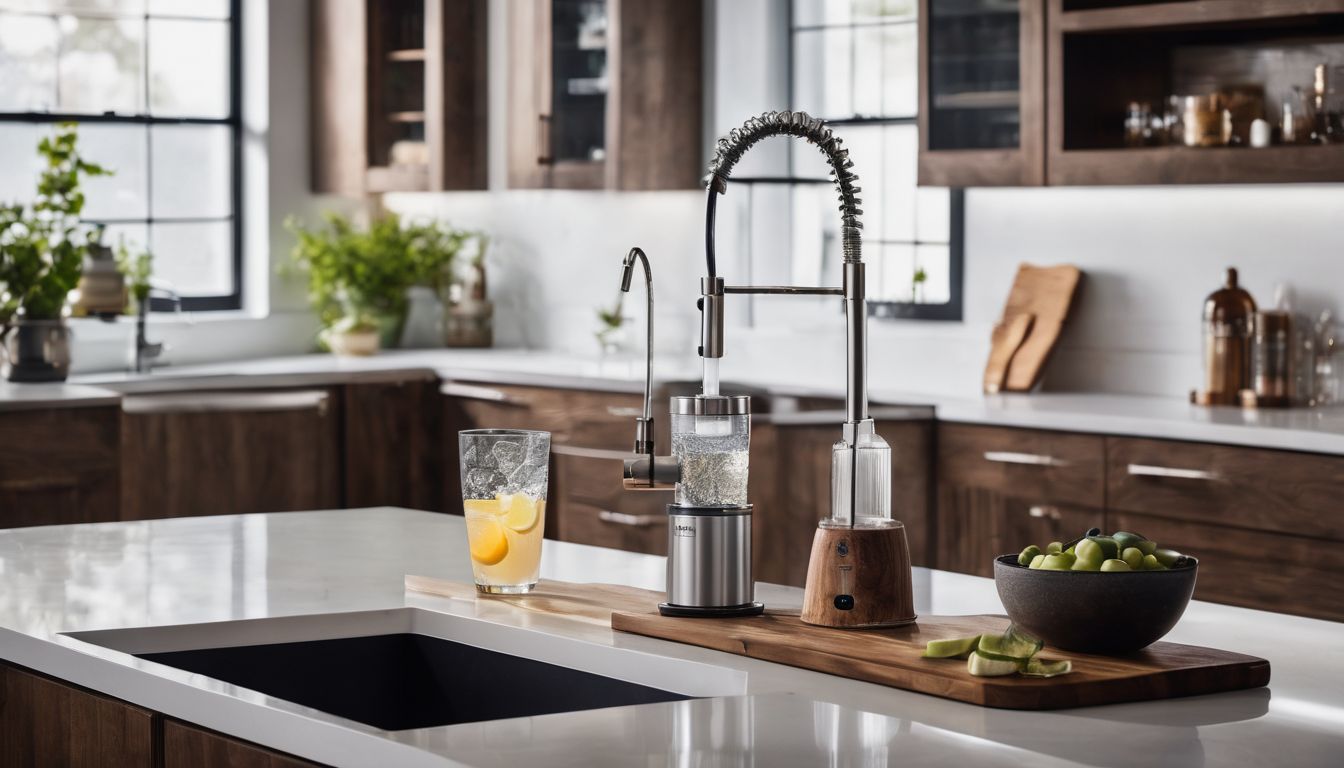Looking for a home can be overwhelming, with soaring costs and complex building processes. Modular homes are rising as a savvy solution, blending affordability with modern design. This post unpacks the benefits of choosing modular construction, from your wallet to your well-being.
Discover why many now say ‘yes’ to these innovative abodes.
Key Takeaways
- Modular homes are cost-effective, reducing construction costs by up to 20% and offering long-term savings through energy-efficient designs.
- They provide design flexibility with customisable options that can incorporate eco-friendly materials and technologies for sustainable living.
- The controlled factory environment of modular home production leads to faster construction times, enhanced quality control, and comfortable working conditions for staff.
- These homes have increased durability due to high – quality materials and precision engineering which endures transportation and assembly rigors.
- Environmentally conscious individuals should consider the location, financing options, building codes, permits, and insurance policies specific to modular homes.
What are Modular Homes?
Modular homes are prefabricated houses that are constructed in sections or modules and then transported to the building site for final assembly. They are similar to manufactured homes but differ in construction methods and building standards.
Definition
Prefabricated homes, also known as modular homes, are residences constructed in sections or modules within a factory setting. These modules are then transported to the building site where they get assembled into a single structure on a permanent foundation.
Unlike traditional construction methods that face delays due to weather and on-site challenges, the factory environment ensures consistent quality and efficiency.
This method of home-building offers not only potential savings but aligns with sustainable housing practices by reducing waste and optimising resources. Each module is designed to meet strict building standards, ensuring long-term value and durability once they’re pieced together on-site.
With energy efficiency at the forefront of design blueprints, these customisable homes present an attractive option for those who advocate for environmental conservation.
Similarities and Differences with Manufactured Homes
Modular homes are similar to manufactured homes in that they are both constructed off-site in a factory setting. However, the key difference lies in the building codes and standards each type must adhere to.
Modular homes typically comply with local building codes, while manufactured homes follow federal codes set by the U.S. Department of Housing and Urban Development (HUD). Additionally, modular homes can be assembled on various foundations such as basements or crawl spaces, whereas manufactured homes are commonly placed on steel chassis.
The construction process is another point of comparison. Prefabricated parts make up both modular and manufactured homes; however, modular home sections must meet state and local building standards before transportation to the construction site.
Conversely, delivered as a complete unit on its steel chassis, manufactured homes bear no restrictions during transport due to their classification as personal property rather than real estate.
Advantages of Modular Homes
Modular homes offer lower cost, design flexibility, faster construction, enhanced quality control and comfortable working conditions in factories. They also provide increased customisation options and greater durability compared to traditional homes.
Lower Cost
Modular homes offer a cost-effective housing solution, reducing construction expenses by up to 20% compared to traditional site-built homes. Through efficient building methods and bulk material purchasing, modular construction minimises waste and optimises resource usage, contributing to sustainable living while offering an affordable alternative for environmentally conscious individuals seeking long-term value.
The lower cost of modular homes extends beyond the initial purchase price, as their energy-efficient design lowers ongoing utility bills and reduces environmental impact through green building practices.
With customisable options for every budget, individuals can invest in a home that aligns with their sustainability goals without compromising on quality or comfort.
Design Flexibility
After considering the lower cost of modular homes, it’s important to explore their design flexibility. Modular homes offer a wide range of customisable options to suit individual preferences and environmental principles.
The flexible design can incorporate eco-friendly materials and energy-efficient features, aligning with sustainable living values.
Modular homes contribute to conservation efforts by providing versatile designs that accommodate various environmental concerns. Customisation allows homeowners to integrate green technologies, such as solar panels or rainwater harvesting systems, into their home’s structure.
Faster Construction
Modular homes offer faster construction times compared to traditional site-built homes. This rapid construction is due to the controlled environment of the factory where weather delays and other external factors are minimised.
The assembly line process used in modular home construction significantly reduces the time it takes from start to finish, making it an efficient and time-saving option for those seeking a quick turnaround on their new home.
The speed of construction not only benefits homeowners by providing faster occupancy but also reduces overall costs associated with building, such as financing and rental expenses during the construction period.
Enhanced Quality Control
With faster construction comes enhanced quality control. Quality is closely monitored at every stage of the modular home building process, from design to final assembly. This rigorous oversight ensures that each module meets high industry standards and complies with local building codes.
State-of-the-art technology and precision machinery contribute to maintaining consistent quality throughout production, resulting in durable and energy-efficient homes that meet the expectations of environmentally conscious individuals.
In addition, the controlled factory environment enables manufacturers to implement sustainable practices such as waste reduction and efficient resource management. For those focused on conservation and environmental sustainability, the increased attention to detail during manufacturing aligns with their values while ensuring a high-quality end product.
Comfortable Working Conditions in Factory
In addition to enhanced quality control, the factory setting in which modular homes are constructed offers comfortable working conditions for the workers. The indoor environment allows for consistent working temperatures and protection from weather-related hazards, ensuring a safer and more pleasant work atmosphere.
This controlled environment also minimises exposure to outdoor pollutants and allergens, promoting better air quality within the factory.
The factory setup further provides access to modern equipment and tools that facilitate efficient construction processes. Workers benefit from ergonomic workstations and proper lighting, contributing to productivity while reducing the risk of workplace-related injuries.
Increased Customisation Options
Modular homes offer increased customisation options, allowing homeowners to tailor their living space to their specific needs and preferences. This includes selecting floor plans, interior finishes, and exterior designs to create a unique and personalised home.
With the ability to choose from a wide range of fixtures, materials, and architectural styles, individuals can create a space that reflects their individuality while also contributing to environmental conservation by integrating sustainable features.
Moreover, environmentally conscious individuals can embrace eco-friendly design elements such as energy-efficient appliances, solar panels, and recycled building materials to minimise their ecological footprint.
Greater Durability
To top off its benefits, modular homes offer greater durability. These structures are designed to withstand transportation and assembly, ensuring long-lasting stability as a permanent residence.
With the use of high-quality materials and advanced construction techniques in a controlled factory setting, modular homes can endure harsh weather conditions and maintain structural integrity over time.
Moreover, the precision engineering involved in constructing modular homes leads to sturdy foundations and robust structures that provide homeowners with peace of mind regarding their investment’s longevity.
Factors to Consider Before Purchasing a Modular Home
Before purchasing a modular home, consider factors such as location, available financing options, local building codes and permits, and insurance policies. To learn more about the advantages of modular homes and potential disadvantages to look out for, keep reading!
Location
The location of your modular home can greatly impact its long-term value and cost-effectiveness. Consider the land cost, local building codes, and zoning regulations before selecting a site.
Ensure that the location allows for flexible design options while complying with environmental conservation efforts.
When choosing the right location for your modular home, it is essential to assess available financing options and insurance policies in your selected area. By carefully considering these factors, you will be able to maximise the benefits of prefabricated homes while supporting conservation and environmental sustainability through responsible placement.
Available Financing Options
Before investing in a modular home, it’s crucial to explore available financing options. Many lenders now offer specific loans tailored to factory-built homes, making it easier for environmentally conscious individuals to finance their dream sustainable residence without breaking the bank.
These financing options can often provide competitive interest rates and flexible terms, ensuring that customisable and cost-effective housing remains within reach.
Furthermore, some financial institutions may also offer green mortgages or energy-efficient mortgages designed specifically for environmentally friendly housing solutions such as modular homes.
Local Building Codes and Permits
Before purchasing a modular home, it’s crucial to consider local building codes and permits. Each area has its own regulations governing the construction of homes, and obtaining the necessary permits ensures that your modular home meets these standards.
Familiarising yourself with local building codes can also help you plan for any potential modifications or upgrades required to comply with these regulations.
Understanding the specific requirements in your area will ensure a smooth and hassle-free construction process, allowing you to enjoy all the benefits of your new environmentally friendly modular home without any unexpected delays or setbacks.
Insurance Policies
When considering purchasing a modular home, it is essential to explore insurance policies tailored to these factory-built homes. Insurance for modular homes provides protection not only during the construction phase but also once the home is completed and occupied.
It’s important to look for insurance policies that cover transportation of modules to the site, as well as comprehensive coverage for any potential damages during assembly and installation.
Additionally, ensuring that your policy covers all aspects of living in a modular home, including long-term structural integrity and custom fixtures, will provide peace of mind.
Potential Disadvantages of Modular Homes
When considering modular homes, it’s important to be aware of the limitations in customisation options, possible delays in delivery, and higher transport costs. These factors can impact your overall experience with modular home construction.
Limited Customisation Options
Limited customisation options may be a drawback for those seeking unique design features. While modular homes offer some level of customisation, there are limitations compared to traditional on-site construction.
The pre-designed modules can restrict the ability to fully personalise the home to individual preferences, potentially limiting the creative expression and bespoke features that some homeowners desire.
Those passionate about sustainability might find limited customisation options frustrating as it may hinder their attempts to incorporate eco-friendly materials or energy-efficient technologies, which could impact the long-term value and environmental footprint of their home.
Possible Delays in Delivery
Limited customisation options may also lead to possible delays in delivery of modular homes. This is because the manufacturing process can be hindered by factors such as material availability, weather conditions, and production capacity.
As a result, there is a risk that the agreed-upon timeline for delivery may not be met, causing potential inconvenience for homeowners expecting to move into their new residence within a specific timeframe.
Factors such as these should be carefully considered when deciding whether to invest in a modular home, particularly when time constraints are an important consideration.
High transport costs could also contribute to potential delays in delivery of modular homes. Shipping modules from the factory to the building site can be affected by logistical challenges and unexpected complications on the road.
Higher Transport Costs
When considering modular homes, it’s essential to factor in the potential increase in transport costs. These costs can vary depending on the distance between the factory and your site, as well as the size and complexity of the modules being transported.
It’s important to work with a reputable manufacturer who can provide transparent information about transportation costs, ensuring that you have a clear understanding of this aspect before making any commitments.
Moreover, minimising environmental impact by exploring greener transportation options is crucial for environmentally conscious individuals. Look for manufacturers who prioritise eco-friendly shipping methods or have initiatives to offset carbon emissions from transportation.
Conclusion
In conclusion, modular homes offer cost-effective and customisable housing options. Their construction speed and enhanced quality control make them a practical choice for environmentally conscious individuals.
With their long-term value and comfortable working conditions in the factory, modular homes provide an attractive alternative to traditional on-site construction.
FAQs
1. What makes modular homes a cost-effective housing option?
Modular homes are factory-built, which streamlines the construction process and results in significant savings compared to traditional on-site building methods.
2. Can I customise my modular home to suit my preferences?
Yes, you can choose from various design options as modular homes offer customisation choices that cater to different styles and needs.
3. Do modular homes have long-term value like traditionally built houses?
Certainly, with their durable construction and quality materials, modular homes maintain long-term value much like their site-built counterparts.
4. How quickly can a factory build a modular home?
Factory-built advantages mean that modular homes are constructed much faster than traditional houses due to controlled environment production processes that reduce delays.





